Laptop Mag Verdict
The Kensington VeriMark Fingerprint Key puts biometric security in a convenient, portable package, giving you a fingerprint login for Windows Hello and other sites that can go with you wherever you take your laptop.
Pros
- +
Accurate sensor reads prints scanned at any angle
- +
Tiny size is portable and convenient
- +
Easy to set up for Windows Hello
Cons
- -
No indicator light
- -
Non-Windows setup and use is a little complicated
Why you can trust Laptop Mag
Ever since the introduction of Windows 10, biometric security options have been supported on PCs ranging from the expected premium systems down to the most basic budget-friendly systems. While some laptops have special webcams for facial recognition, fingerprint logins have become a standard for many systems, but they're far from ubiquitous. Now there's an option for fingerprint-based security on any Windows 10 PC, with the Kensington VeriMark Fingerprint Key, a tiny USB fingerprint reader. The tiny USB device combines a compact USB dongle, a 360-degree fingerprint sensor, FIDO U2F certification for use in two-factor logons, and works with popular password managers like Dashlane, LastPass and Keeper. It's small enough to leave plugged into any Windows PC, even a laptop that goes in and out of your bag, letting you take it on the go for security anywhere you happen to be.
Design
The compact design is built with portability in mind, with a low-profile dongle and a cover that attaches to a key chain. The ability to easily carry the scanner with you from one PC to another with your pocket change makes it immensely more portable than the scanners of even a year ago, which were generally clunky affairs that attached via a short USB cable.
The BIO-Key EcoID Fingerprint Reader, for example, had a 1.25 x 2.25 x 0.3-inch rectangular design, and the more portable Bio-Key SideTouch measured 0.8 x 0.9 x 0.66 inches. By comparison, the compact Kensington VeriMark Fingerprint Key measures a mere 0.4 x 0.6 x 1.2 inches, and the majority of that is inserted into the USB port. It's actually small enough that you can safely leave it plugged in as you slip your laptop into a bag for your commute. Really the only gripe I have with the product is the lack of an indicator light to signal when the USB device is plugged in and working.
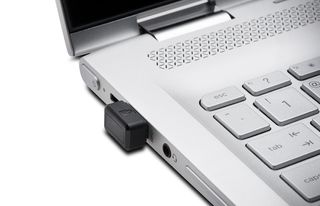
If you don't want to leave it plugged in, you can also attach it to a lanyard or key chain thanks to a secure cover that comes with it. This cover protects the USB plug from dirt and pocket lint, and helps you keep track of the USB when not in use. The black plastic cover clicks into place and holds on tight, requiring a bit of force to pull it back off - there's no worry that your tiny fingerprint scanner will fall out and get lost.
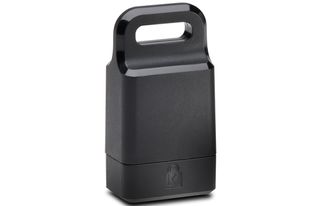
The Kensington VeriMark Key uses a 0.4 x 0.6-inch sensor that can read your fingerprint in theoretically every angle you might use it at. That flexibility is nice, without the finicky read errors you might see on unidirectional sensors. In our setup and use of the fingerprint scanner we never had any issue with misread scans and had (predictably) zero success at signing in with a different fingerprint. As long as you use the correct finger, you can sign right into your Windows account.
Setup
To set up the sensor and register your fingerprint, you first need to set up your Windows account. In your Windows settings, you can secure your account with a PIN code. If you haven't set this up previously, you'll need to do this before registering your fingerprint.
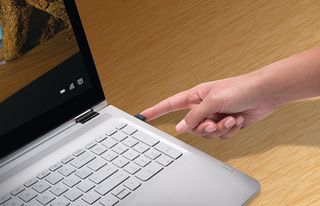
Plug in the USB and it will automatically install the needed software drivers. Open your Windows settings and choose "Accounts." Under your account you will see several sign-in options, with a portion of the Menu marked "Windows Hello." Scroll down until you find the fingerprint option, and click the button to begin setup.
This will welcome you to Windows Hello, and asks you to verify your identity with your PIN number. Once you've done this, you'll be prompted to scan your finger on the fingerprint reader. You have the option of scanning in one or two fingers. Once that's done, you're all set, and can use the fingerprint reader to sign in to Windows Hello. However, it's only set up on the PC you used. You'll also need to set it up individually for each PC you want to use it on, since the device doesn't store any fingerprint data on the device; it's a reader only.
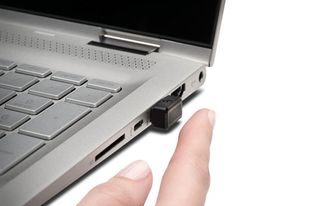
Once you have your print registered, you can also set up the scanner to log you into other accounts. The tiny dongle comes with VeriMark's password management tool preinstalled, letting you establish complex and unique logins for all of your online accounts, and sign in and out with a touch of your finger. In our testing, setting it up with LastPass let us sign into websites with our fingerprint, but it was a clunky process that often took more than one attempt to work - not because the fingerprint wasn't accepted, but because the fingerprint-to-login transition didn't always work seamlessly.
MORE: 10 Worst Data Breaches of All Time
You can also set it up as a second-factor logon for various cloud-based services. This process is a little less straightforward, with separate instructions for enabling U2F on Dropbox, Facebook, GitHub and Google.
Cost and Competition
The Kensington VeriMark Fingerprint Key sells for $49.99, which is far less expensive than the fingerprint readers of years past, which often sold for upward of $100. It is more expensive than the Bio-Key SideTouch, a similar dongle that sells for $39.99, but is too large to leave plugged in when you take your laptop in and out of a bag.
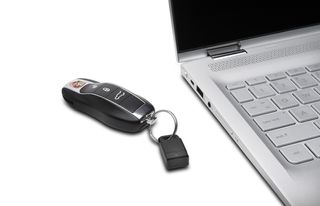
Similar products on the market range between $25 and $75, so the VeriMark model is right in line with other products. It also has the added benefits of the 360-degree readability, better anti-spoofing technology and - compatibility with most password managers, which competing products may not offer.
Bottom Line
The Kensington VeriMark USB Fingerprint Key is just what you want security to be: convenient and simple to use while being uncompromising and accurate in its security functions. This small fingerprint reader does just that with its simple setup for Windows Hello, a tiny design that goes anywhere, and a sensor that removes some of the headaches often associated with fingerprint scanners. It's a little pricier than some, but for trusted security from an established brand, it's a great choice.
Credit: Kensington
